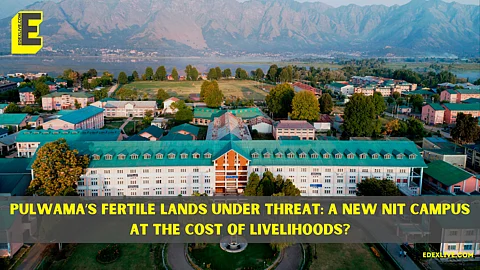

In a move that has sparked widespread debate, the Pulwama district in Kashmir, known for its rich agricultural lands and pristine kareawas, faces yet another developmental challenge.
On December 24, 2024, the office of the Deputy Commissioner (DC) Pulwama issued an order to transfer over 4,834 kanals (around 604 acres) of land in Newa Pulwama for a proposed sub-campus of the National Institute of Technology (NIT) Srinagar. While the project promises to improve higher education infrastructure, it has drawn sharp criticism from locals, environmentalists, and even students.
The fertile kareawas of Pulwama, once celebrated for producing almonds, saffron, and apples, have faced steady destruction over the last two decades due to infrastructural projects like highways and railway lines. This new proposal could be another nail in the coffin for the remaining agricultural patches preserved by local farmers.
Voices of concern: students speak out
The proposed sub-campus has evoked mixed reactions.
Nasir Khuehami, the National Convener of the Jammu and Kashmir Students’ Association, voiced a balanced opinion. While he acknowledged the urgent need for better educational infrastructure in Kashmir, he raised concerns about the scale and logic of the project.
“It’s baffling that the proposed sub-campus at Pulwama is planned to be nearly 16 times larger than the main NIT campus in Srinagar, which occupies just 250 kanals. This raises questions about the rationale behind the project,” said Khuehami.
He stressed that although Kashmiri students desperately need better educational opportunities to reduce migration to other states, the government must not overlook the livelihoods of Pulwama’s farmers. “We support development but not at the cost of fertile lands and people’s livelihoods. The agricultural land in Kashmir is already shrinking due to highways and other projects. Destroying resources in the name of development is counterproductive,” he added.
Balancing infrastructure and ecology
Shahid, a current student at NIT Srinagar, shared a nuanced perspective. “There’s no doubt that the current campus needs significant improvements. Our labs are poorly equipped, and we don’t even have hostel facilities. A new campus could provide better infrastructure, attract renowned faculty, and generate employment. But at what cost? Using fertile, biodiverse land for concrete buildings is a step backwards,” he said.
Shahid emphasised that any developmental project must balance economic progress with environmental and social responsibilities. “The government should address the concerns of the local community and ensure proper compensation if the project proceeds,” he said.
Could the existing campus be improved instead?
Muhammad Salman, a fourth-year chemical engineering student at NIT Srinagar, questioned the logic of building an entirely new campus when the existing one is underfunded.
“NIT Srinagar is one of the oldest NITs in India, but its infrastructure is far from adequate. Instead of building a new campus, why not invest in improving the current one? Many buildings here are single-storied; we could add floors instead of destroying agricultural land in Pulwama,” he suggested.
Salman also highlighted a critical issue affecting students: Placements.
“Constructing a bigger campus won’t help if branches like chemical engineering continue to face poor placement opportunities. The focus should be on improving labs, adding facilities, and addressing real academic concerns,” he said.
The larger debate: Development vs livelihoods
At the heart of the controversy lies the question of prioritising development over livelihoods.
Pulwama’s orchards and fertile lands have supported generations of families, and their destruction threatens not only their income but also the region’s ecological balance. Critics argue that the government often greenlights projects without thorough environmental impact assessments or consultations with local communities.
The government’s justification for such large-scale land acquisition is rooted in the promise of progress. A state-of-the-art NIT campus could potentially put Kashmir on the map as a hub for technical education. But locals and students alike argue that this progress must not come at the expense of the very people it aims to benefit.
As this debate unfolds, the government must engage with all stakeholders, conduct proper environmental assessments, and ensure fair compensation for those affected. Development must not be a zero-sum game, students said.
